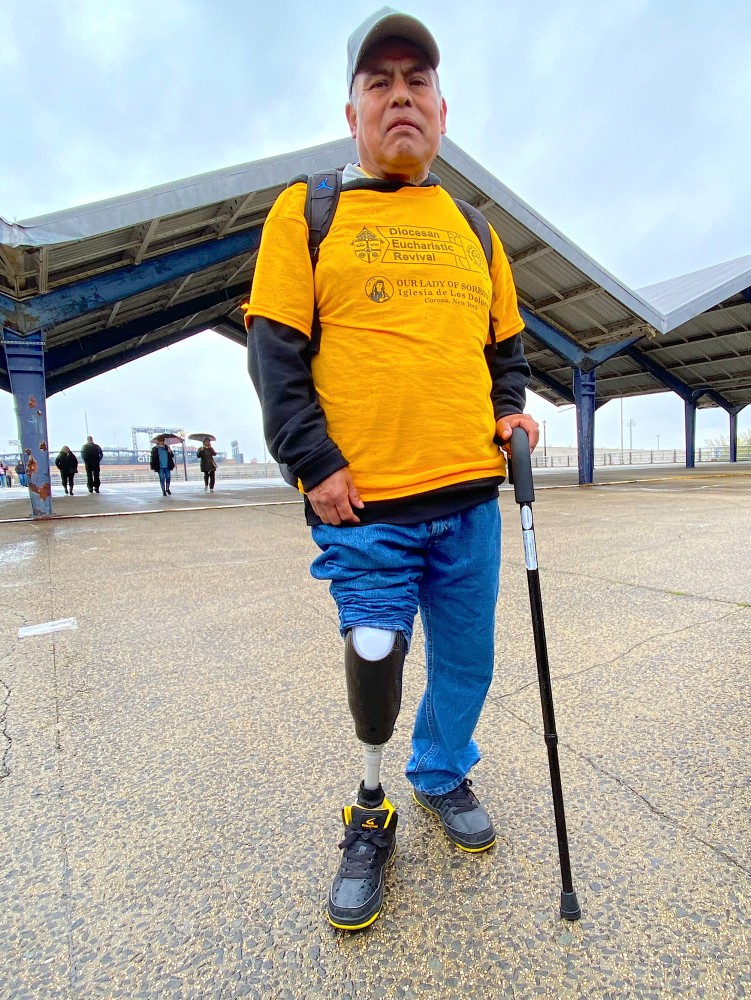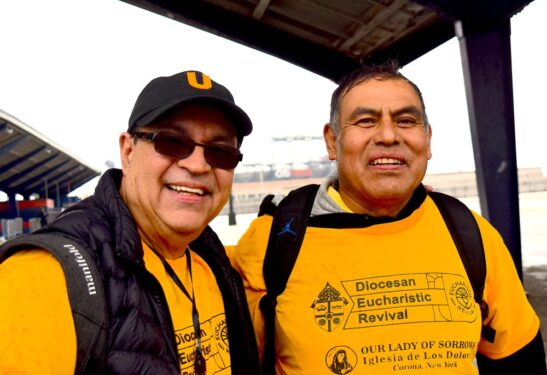
CORONA — A wave of humanity — 1,476 strong and dressed in yellow T-shirts — poured from Our Lady of Sorrows Parish in Corona on Saturday, April 20, destined for the Diocese of Brooklyn’s first-ever Eucharist Revival.
The venue was 1.3 miles away at Louis Armstrong Stadium, where the procession became part of the diocesan-wide congregation of more than 6,500 adorers of Christ in the form of the Eucharist.
A short distance away came another man, also wearing the yellow shirt, walking with a cane and an obvious limp.
“Hey, that’s my friend,” said fellow parishioner Ramon Polanco. “He has a prosthetic leg.”
Polanco explained that he met Fortunato Benavides Rosales through the “Brotherhood of Emaús.” This national organization helps Catholics deepen their faith and move into discipleship for the New Evangelization.
Our Lady of Sorrows started a local chapter in 2022.
Polanco decided to hang back and walk the rest of the way with his Emaús buddy. Benavides is from Mexico; Polanco, a native of the Dominican Republic, interpreted for him.
Benavides, who lost his right leg to thrombosis, said he was handling the procession OK.
“I just can’t walk fast,” he said.
His new prosthetic, about four months old, wasn’t giving him any trouble on Saturday. Instead, he was dealing with some back pain.
The two men briefly chatted and joked to get caught up since they last met.

Polanco explained that the Emaús organization based its name on Luke 24:13-35, in which two men journeying from Jerusalem to the town of Emmaus grieved Christ’s crucifixion just a couple days before.
A third man joined them, although they did not know him — or so they thought. He was Jesus, risen from the dead, who disappeared right after revealing his identity to them.
Like the two men headed to Emmaus, Polanco and Benavides continued their trek to the stadium. But unlike the two pilgrims described by St. Luke, these men knew that Christ awaited them in the stadium — as the Eucharist.
Asked why he chose to come, Benavides said, “Es importante porque Dios es primero. Dios es mi vida.” (“It’s important because God is first. God is my life.”)
He was not the only modern-day pilgrim to endure discomfort to attend the revival.
Father Carlos Agudelo, pastor of St. Leo’s Parish in Corona, said about 400 of his parishioners also formed a procession to the event. Two of them, he said, have been undergoing chemotherapy for cancer.
The pastor said they didn’t complain during the walk or the long wait to enter the gates.
“You see that and you say, ‘Now there’s a love for the Eucharist,’” Father Agudelo said. “They are weak, physically, and yet they were walking with us to the stadium. And they remained the whole time. They were praying and people were helping them.
“That touched my heart.”
